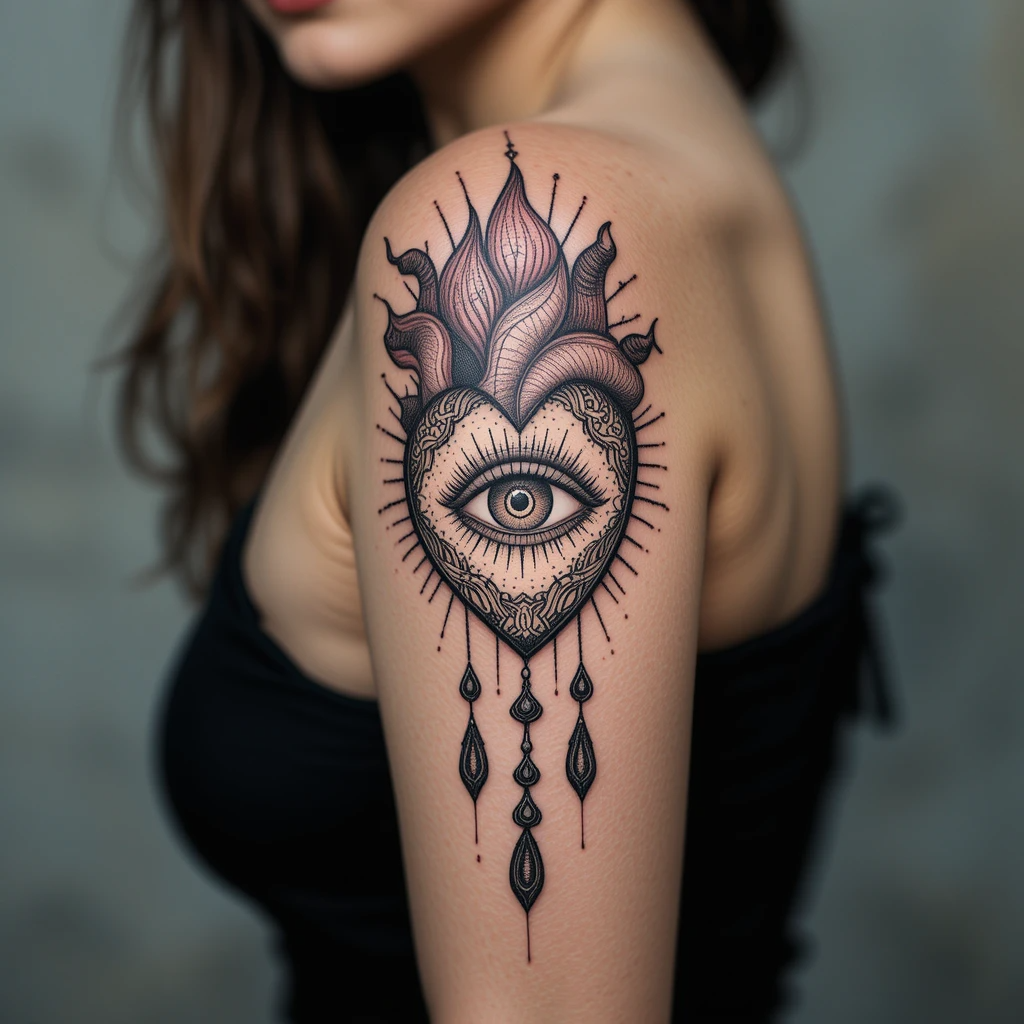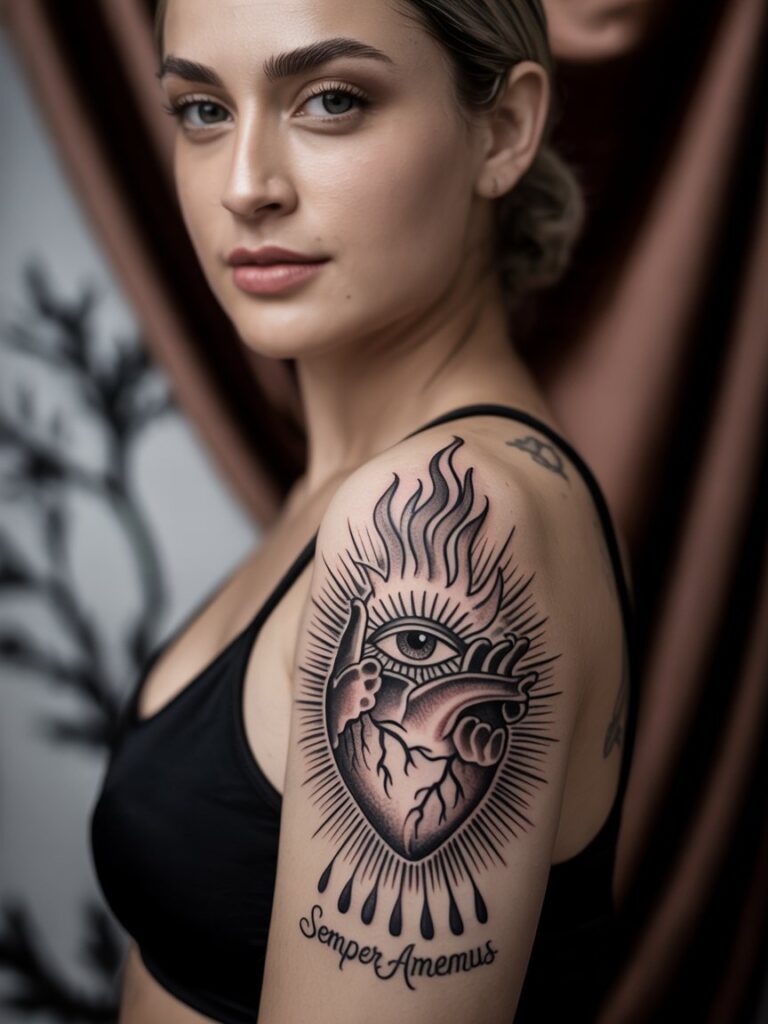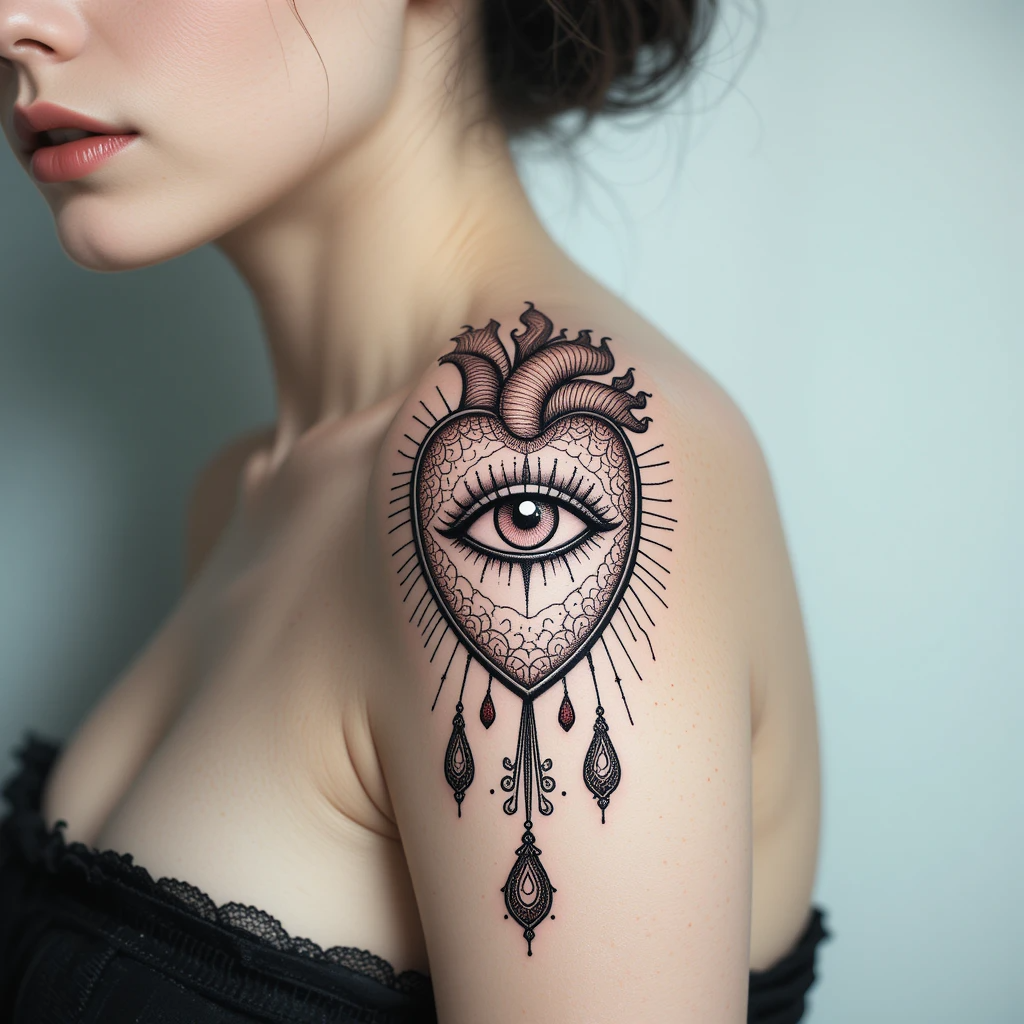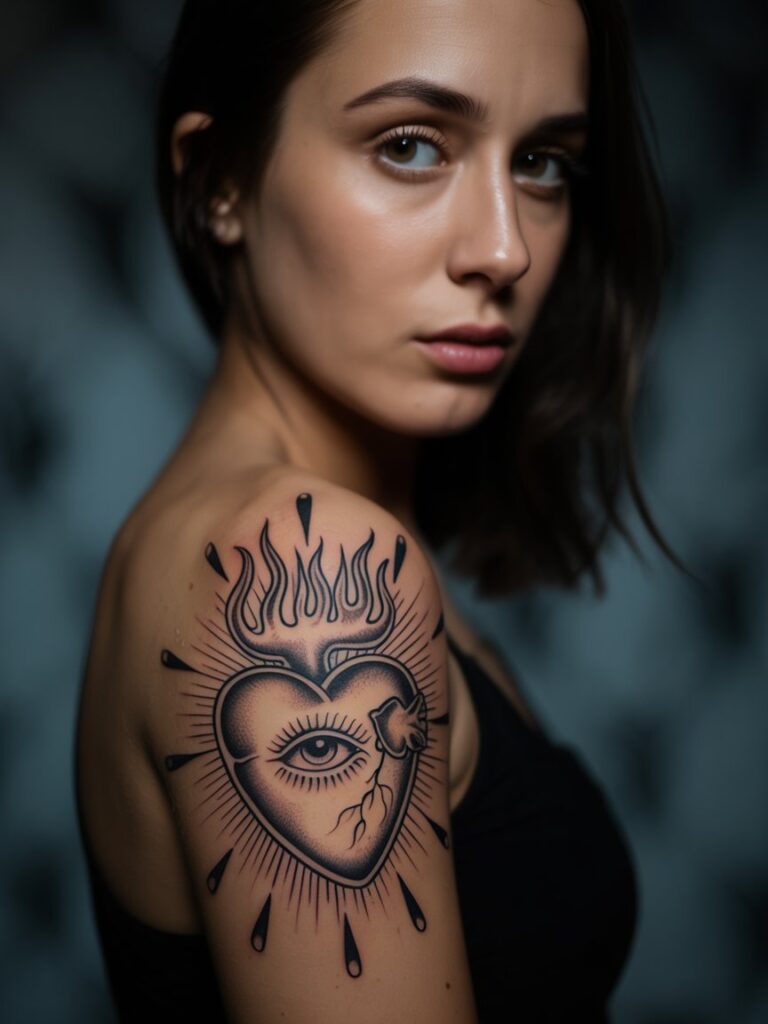In the profound realm of spiritual body art, few symbols carry the transformative power and sacred resonance of the Sacred Heart. These magnificent tattoos merge centuries of religious devotion with contemporary artistic mastery, creating body art that speaks to both aesthetic excellence and profound spiritual awakening. The stunning tattoos showcased here demonstrate how contemporary artists transform ancient sacred imagery into sophisticated statements of faith, love, devotion, and humanity’s eternal quest for divine connection and spiritual transcendence.
The Sacred Symbolism of Divine Love
The Sacred Heart stands as Christianity’s most powerful symbol of divine love, carrying meanings that span from personal redemption to universal compassion, from spiritual transformation to the soul’s eternal journey toward divine union.
The Sacred Heart as Universal Expression of Divine Love
Throughout Christian tradition, the Sacred Heart has served as the ultimate symbol of God’s love for humanity:
- Divine Compassion: The heart as vessel of infinite love and mercy for all creation
- Sacrificial Love: Christ’s willingness to suffer and die for humanity’s salvation and redemption
- Spiritual Transformation: The heart as symbol of personal conversion and spiritual awakening
- Eternal Devotion: The perpetual nature of divine love transcending time and human limitation
- Sacred Wound: The pierced heart representing both suffering and the source of healing grace
- Burning Love: Flames symbolizing the intensity and purifying power of divine passion
When rendered in tattoo form, these ancient meanings take on contemporary relevance, offering wearers connection to timeless spiritual experiences while expressing deeply personal relationships with the divine and sacred tradition.
The Anatomy of Sacred Symbolism
The Sacred Heart embodies multiple layers of symbolic meaning through its distinctive visual elements:
- The Physical Heart: Anatomical realism representing the incarnation of divine love in human form
- Crown of Thorns: Christ’s passion and the cost of redemption through suffering and sacrifice
- Piercing Wounds: The crucifixion wounds as sources of grace and spiritual healing
- Radiating Light: Divine glory and the illuminating power of sacred love
- Consuming Flames: Purifying fire of divine love that transforms and sanctifies souls
- Weeping Blood: The price of salvation and the depth of divine compassion for human suffering
This rich symbolic vocabulary makes Sacred Heart tattoos powerful expressions of faith that operate on multiple levels of meaning, connecting personal devotion to universal spiritual truths.
The Art of Sacred Iconography in Contemporary Tattoo Culture
These Sacred Heart tattoos represent a sophisticated approach to religious art, demonstrating how traditional Christian iconography can be transformed into stunning body art through masterful technique and spiritual sensitivity.
Technical Mastery in Sacred Art Execution
The technical execution visible in these pieces showcases several advanced tattoo techniques essential for religious imagery:
- Anatomical Precision: Creating hearts that balance realistic anatomy with symbolic representation
- Sacred Geometry: Incorporating traditional proportions and symbolic mathematical relationships
- Light and Shadow: Using chiaroscuro techniques to create divine illumination and spiritual depth
- Ornamental Detail: Rendering intricate decorative elements that enhance rather than distract from sacred meaning
- Symmetrical Balance: Achieving perfect compositional harmony while maintaining spiritual focus
- Symbolic Clarity: Ensuring every element serves both aesthetic beauty and religious significance
This level of technical execution requires exceptional skill in both religious iconography and advanced tattoo application, representing the highest standards of contemporary sacred art.

The Philosophy of Sacred Art Translation
These Sacred Heart designs embody important principles of translating religious art into tattoo form:
- Reverent Accuracy: Respecting traditional iconographic elements while adapting for contemporary expression
- Spiritual Enhancement: Elevating traditional forms through sophisticated composition and modern technique
- Devotional Purpose: Ensuring artistic choices serve spiritual meaning rather than mere decoration
- Timeless Quality: Creating designs that honor both religious tradition and contemporary aesthetic standards
- Sacred Execution: Demanding flawless skill since religious art tolerates no compromise in quality
- Meaningful Clarity: Maintaining spiritual significance despite complex visual information
This approach reflects deep understanding of both artistic tradition and contemporary spiritual needs, creating tattoos that serve as genuine expressions of faith rather than mere decorative elements.
Historical Context and Religious Tradition
Sacred Heart tattoos connect to nearly two millennia of Christian devotion and theological development, representing one of Catholicism’s most beloved and significant devotional traditions.
The Development of Sacred Heart Devotion
The Sacred Heart tradition emerged from centuries of Christian mystical experience and theological reflection:
- Early Christian Origins: Patristic writings about Christ’s pierced heart as source of sacramental grace
- Medieval Mysticism: Contemplative traditions focusing on Christ’s heart as center of divine love
- Saint Margaret Mary Alacoque: 17th-century French mystic who received private revelations about Sacred Heart devotion
- Papal Endorsement: Official Church recognition and promotion of Sacred Heart devotion and liturgy
- Global Spread: Worldwide adoption of Sacred Heart imagery in Catholic art and popular devotion
- Modern Renewal: Contemporary movements returning to traditional Catholic spirituality and imagery
This rich historical development provides Sacred Heart tattoos with deep spiritual roots and connection to centuries of Christian contemplative tradition.
Theological Significance and Spiritual Meaning
The Sacred Heart carries profound theological significance within Christian doctrine:
- Incarnation Mystery: The heart as symbol of God becoming human and taking on human emotions
- Trinity Revelation: Sacred Heart devotion as path to understanding divine love within trinitarian theology
- Redemption Focus: The heart as center of Christ’s salvific work and sacrificial love
- Mystical Union: Sacred Heart as pathway to intimate relationship with divine love
- Social Justice: Connection between divine love and obligation to love and serve others
- Eschatological Hope: Sacred Heart as promise of eternal life and final redemption
These theological depths make Sacred Heart tattoos powerful tools for maintaining connection to core Christian beliefs and spiritual practice.
Cultural Contexts and Artistic Traditions
Sacred Heart imagery draws from rich traditions of Christian art spanning centuries of artistic development and cultural expression.
European Sacred Art Heritage
The Sacred Heart tradition emerged from Europe’s greatest artistic and spiritual movements:
- Byzantine Iconography: Eastern Christian traditions of sacred art and theological symbolism
- Gothic Spirituality: Medieval emphasis on Christ’s humanity and emotional connection to divine suffering
- Baroque Sensuality: Counter-Reformation art emphasizing emotional engagement and sensory spiritual experience
- Romantic Devotion: 19th-century emphasis on personal relationship with Christ and intimate spirituality
- Folk Traditions: Popular devotional art expressing common people’s relationship with sacred imagery
- Contemporary Revival: Modern movements returning to traditional Catholic aesthetics and spirituality
This artistic heritage provides Sacred Heart tattoos with sophisticated visual vocabulary and deep cultural resonance.

Global Catholic Artistic Expression
Sacred Heart imagery manifests differently across various Catholic cultural regions:
- Latin American Folk Art: Vibrant colors and indigenous artistic elements integrated with Catholic symbolism
- European Classical Tradition: Formal religious art emphasizing theological precision and artistic excellence
- Asian Catholic Art: Integration of local artistic traditions with Catholic imagery and symbolism
- African Catholic Expression: Indigenous artistic styles combined with Christian sacred art traditions
- Contemporary Global Fusion: International artistic movements creating new approaches to traditional Catholic imagery
- Popular Devotional Art: Grassroots artistic expressions reflecting ordinary Catholics’ relationship with sacred symbols
Understanding these global variations helps create tattoos that reflect authentic connection to specific cultural and spiritual contexts.
The Psychology of Sacred Art and Spiritual Identity
Choosing Sacred Heart tattoos reflects deep psychological connections to faith, devotion, spiritual identity, and the human need for transcendent meaning and divine connection.
The Language of Faith: Spiritual Psychology
Sacred Heart tattoos often reflect psychological patterns related to spiritual development and religious identity:
- Faith Expression: Visual commitment to Christian belief and public identification with religious tradition
- Devotional Practice: Permanent reminder of spiritual commitment and daily prayer life
- Identity Integration: Incorporating religious belief into core personal identity and self-expression
- Community Belonging: Connection to broader Catholic community and shared spiritual tradition
- Comfort and Protection: Sacred imagery as source of spiritual comfort and divine protection
- Transformation Documentation: Tattoos marking significant spiritual conversion or religious awakening
These psychological connections make Sacred Heart tattoos particularly meaningful for individuals processing spiritual growth and religious identity development.
The Devotional Mindset: Living Sacred Commitment
The human attraction to Sacred Heart imagery reveals important spiritual truths:
- Love Prioritization: Recognition that divine love is life’s central reality and organizing principle
- Sacrifice Appreciation: Understanding that authentic love requires sacrifice and self-giving
- Compassion Cultivation: Developing Christ-like compassion and concern for others’ suffering
- Spiritual Intimacy: Pursuing personal relationship with God through Christ’s Sacred Heart
- Redemptive Suffering: Finding meaning in personal struggles through connection to Christ’s passion
- Hope Maintenance: Using Sacred Heart devotion to sustain faith during difficult times
Sacred Heart tattoos serve as permanent reminders of these spiritual principles and their relevance to navigating life’s challenges through faith and divine love.
Placement and Composition Strategies for Sacred Imagery
The strategic placement of these Sacred Heart tattoos demonstrates sophisticated understanding of how sacred body art interacts with anatomy, visibility, and the devotional nature of religious symbolism.
The Shoulder as Sacred Canvas
The shoulder placement provides unique opportunities for Sacred Heart display:
- Visibility Control: Placement allowing for both public witness and private devotion
- Anatomical Honor: Working with the body’s natural nobility to enhance sacred imagery
- Size Accommodation: Shoulder area providing sufficient space for detailed sacred iconography
- Movement Integration: Sacred Heart imagery that moves naturally with daily activities and prayer postures
- Symbolic Elevation: Positioning sacred imagery “above” the heart, suggesting spiritual transcendence
- Devotional Access: Placement allowing for easy contemplation and prayer focus
This placement choice reflects deep consideration of both aesthetic impact and spiritual function in daily devotional life.

Upper Back Positioning for Sacred Symmetry
The upper back offers different advantages for Sacred Heart imagery:
- Perfect Balance: Central placement allowing for ideal compositional harmony and symbolic focus
- Canvas Size: Large surface area accommodating detailed sacred art and impressive devotional impact
- Intimate Revelation: Placement creating special moments of witness and spiritual sharing
- Anatomical Flow: Working with the back’s natural contours to enhance sacred imagery
- Protective Symbolism: Sacred Heart positioned as spiritual guardian and divine protection
- Contemplative Location: Back placement suggesting sacred imagery emerging from the soul’s depths
This positioning demonstrates understanding of how placement influences both visual impact and devotional function.
Spiritual Dimensions of Sacred Heart Devotion
Beyond cultural and psychological factors, Sacred Heart tattoos carry profound spiritual significance related to mystical theology, divine union, and contemplative practice.
Mystical Traditions of Sacred Heart Spirituality
In Catholic mystical tradition, the Sacred Heart represents fundamental spiritual realities:
- Divine Love Participation: Sacred Heart as pathway to experiencing God’s love directly
- Contemplative Union: Sacred Heart meditation as method for achieving mystical union with Christ
- Intercessory Power: Sacred Heart devotion as powerful form of prayer and spiritual intercession
- Eucharistic Connection: Sacred Heart as symbol of Christ’s real presence in the Eucharist
- Marian Devotion: Connection between Sacred Heart and Immaculate Heart of Mary
- Reparation Practice: Sacred Heart devotion as way of making reparation for sin and spiritual damage
These mystical dimensions make Sacred Heart tattoos powerful tools for maintaining connection to advanced Catholic spirituality and contemplative practice.
The Sacred Heart as Theological Revelation
The Sacred Heart offers profound insights about divine nature and human relationship with God:
- Divine Accessibility: Understanding that God’s love is available and welcoming to all humanity
- Emotional Divinity: Recognition that God experiences genuine emotions and personal relationships
- Incarnational Theology: Sacred Heart as proof of God’s complete identification with human experience
- Trinitarian Love: Sacred Heart revealing the love relationships within the Trinity itself
- Redemptive Mystery: Understanding salvation through the lens of divine love rather than divine justice
- Eschatological Promise: Sacred Heart as guarantee of eternal life and final union with God
These theological insights transform Sacred Heart tattoos into sacred art that serves contemplative and devotional functions in daily spiritual life.
Contemporary Catholic Identity and Sacred Art
Sacred Heart tattoos create unique opportunities for expressing Catholic identity, traditional spirituality, and commitment to orthodox Christian belief in contemporary secular culture.
Traditional Catholicism in Modern Context
These tattoos complement and enhance traditional Catholic identity expression:
- Counter-Cultural Witness: Sacred Heart imagery as bold statement of religious faith in secular environment
- Liturgical Connection: Sacred Heart tattoos connecting to traditional Latin Mass and classical Catholic liturgy
- Devotional Lifestyle: Integration with traditional Catholic practices like daily rosary and Eucharistic adoration
- Community Identity: Visual connection to traditional Catholic communities and orthodox religious practice
- Aesthetic Testimony: Sacred Heart beauty as argument for Catholic artistic and spiritual tradition
- Evangelization Tool: Tattoos as opportunities for witness and conversation about Catholic faith
Thoughtful integration helps Sacred Heart tattoos enhance overall Catholic identity while providing opportunities for evangelization and witness.

Lifestyle Alignment and Spiritual Practice
Sacred Heart tattoos often reflect and influence spiritual lifestyle choices:
- Prayer Life: Daily devotional practices centered on Sacred Heart spirituality and meditation
- Sacramental Living: Regular participation in Mass, confession, and other Catholic sacraments
- Charitable Works: Commitment to corporal and spiritual works of mercy inspired by Sacred Heart love
- Family Devotion: Integration of Sacred Heart imagery and devotion into family prayer and domestic church
- Religious Education: Ongoing study of Catholic theology and Sacred Heart devotional traditions
- Pilgrimage and Retreat: Travel to Sacred Heart shrines and participation in religious retreats
These lifestyle connections create coherent Catholic identity expression that extends far beyond the tattoo itself into comprehensive spiritual living.
Choosing the Right Artist for Sacred Iconography
The profound spiritual significance and artistic complexity of Sacred Heart tattoos require specialized expertise in religious art and sacred iconographic traditions.
Technical Requirements for Religious Art
Artists specializing in Sacred Heart imagery must demonstrate:
- Iconographic Knowledge: Understanding of traditional Catholic sacred art and symbolic conventions
- Theological Sensitivity: Respect for religious meaning and orthodox Catholic doctrine
- Artistic Excellence: Exceptional skill in realistic illustration and classical artistic techniques
- Sacred Proportion: Understanding of traditional religious art proportions and compositional principles
- Symbolic Precision: Ability to render religious symbols accurately and meaningfully
- Portfolio Evidence: Previous work demonstrating competence in religious and devotional imagery
The sacred nature of Sacred Heart tattoos demands artists who approach religious imagery with both technical excellence and spiritual reverence.
Spiritual Understanding and Religious Sensitivity
Beyond technical competence, the right artist should demonstrate:
- Faith Appreciation: Genuine respect for Catholic tradition and Sacred Heart devotion
- Cultural Awareness: Understanding of Sacred Heart significance across various Catholic communities
- Collaborative Spirit: Willingness to work with clients to achieve authentically devotional results
- Quality Standards: Commitment to excellence befitting sacred imagery and religious art
- Respectful Approach: Sensitivity to the sacred nature of religious tattoo work
- Educational Willingness: Openness to learning about Catholic tradition and Sacred Heart theology
The relationship between artist and client becomes particularly important for achieving religious authenticity and spiritual meaning that Sacred Heart tattoos demand.

Regional Variations and Cultural Authenticity
Sacred Heart imagery manifests differently across various Catholic cultural regions, reflecting local artistic traditions and devotional practices.
Latin American Sacred Heart Traditions
Latin American Catholicism brings distinctive elements to Sacred Heart imagery:
- Folk Art Integration: Vibrant colors and indigenous artistic elements combined with Catholic symbolism
- Popular Devotion: Grassroots religious expression and family-centered Sacred Heart devotion
- Cultural Syncretism: Integration of pre-Columbian artistic traditions with Catholic sacred art
- Festive Spirituality: Sacred Heart imagery connected to religious celebrations and community festivals
- Social Justice: Sacred Heart devotion linked to liberation theology and concern for the poor
- Family Tradition: Multi-generational Sacred Heart devotion and domestic religious practice
These Latin American influences create culturally rich versions of universal Sacred Heart themes.
European Classical Sacred Heart Art
European tradition contributes formal artistic elements to Sacred Heart imagery:
- Classical Proportions: Traditional religious art proportions and compositional principles
- Theological Precision: Careful attention to orthodox Catholic doctrine and iconographic accuracy
- Artistic Excellence: High standards of technical execution and aesthetic beauty
- Liturgical Connection: Sacred Heart imagery connected to formal liturgical worship and cathedral art
- Mystical Tradition: Integration with European contemplative traditions and monastic spirituality
- Historical Continuity: Connection to centuries of European Catholic artistic and spiritual development
Understanding these European traditions helps create tattoos that reflect authentic connection to classical Catholic artistic heritage.
The Economics of Sacred Art Investment
Quality Sacred Heart tattoos represent significant spiritual and financial investments requiring careful consideration and planning.
Pricing Factors for Religious Excellence
Several elements influence the cost of superior Sacred Heart tattoos:
- Artist Specialization: Premium pricing for specialists in religious art and sacred iconography
- Design Complexity: Intricate sacred symbolism requiring extensive theological knowledge and artistic skill
- Size and Detail: Larger Sacred Hearts allowing for more symbolic elements but requiring more time
- Placement Considerations: Shoulder and back work requiring special anatomical understanding
- Studio Reputation: Established shops with proven track records in religious and devotional work
- Geographic Location: Regional variations in pricing and religious art specialist availability
Understanding these cost factors helps in budgeting appropriately for work that will provide lasting spiritual value and devotional meaning.
Long-term Spiritual and Artistic Value
The investment in Sacred Heart tattoos extends beyond initial application:
- Devotional Durability: How religious imagery maintains spiritual significance throughout life changes
- Artistic Aging: Quality religious art maintaining beauty and clarity over decades
- Touch-up Maintenance: Periodic care to preserve sacred imagery and symbolic clarity
- Spiritual Growth: How Sacred Heart tattoos continue providing devotional focus during spiritual development
- Community Connection: Ongoing value as point of connection with Catholic community
- Legacy Consideration: Sacred Heart tattoos as expression of faith that may influence family and descendants
Viewing Sacred Heart tattoos as long-term spiritual investments helps ensure decisions that provide lasting devotional value and religious meaning.
The Social Impact of Sacred Art in Secular Culture
Sacred Heart tattoos influence not only personal spiritual identity but also broader cultural conversations about faith, tradition, and religious expression in contemporary society.
Evangelization Through Sacred Art
These tattoos contribute to important evangelization work in secular culture:
- Visual Witness: Sacred Heart imagery as bold testimony to Catholic faith in secular environments
- Conversation Starters: Tattoos creating opportunities for religious dialogue and faith sharing
- Cultural Presence: Maintaining Catholic identity and imagery in increasingly secular artistic spaces
- Artistic Evangelization: Using beauty and excellent art to attract interest in Catholic faith
- Traditional Revival: Supporting renewal of traditional Catholic spirituality and devotion
- Counter-Cultural Statement: Sacred Heart imagery as alternative to secular and materialistic values
This evangelization function extends Sacred Heart tattoos beyond personal devotion to active participation in the Church’s mission.
Building Catholic Community Through Sacred Art
Sacred Heart tattoos create connections among Catholics who share commitment to traditional spirituality:
- Devotional Communities: Supporting networks of Catholics committed to Sacred Heart spirituality
- Traditional Movements: Connecting with renewal movements focused on classical Catholic practice
- Artistic Patronage: Supporting artists who specialize in authentic Catholic sacred art
- Liturgical Communities: Building relationships with Catholics committed to traditional liturgical worship
- Educational Networks: Connecting with Catholics interested in theological education and spiritual formation
- Family Traditions: Strengthening family bonds through shared Catholic identity and religious practice
These community-building functions make Sacred Heart tattoos powerful tools for Catholic social connection and mutual spiritual support.
Conclusion: Wearing Divine Love as Eternal Commitment
Sacred Heart tattoos represent one of contemporary Catholic culture’s most profound and meaningful artistic traditions. These exquisite images unite Christianity’s central mystery of divine love with contemporary understanding of faith expression, creating deeply devotional art that speaks to universal spiritual longings while honoring individual relationships with Christ and Catholic tradition.
The exceptional examples showcased here demonstrate how skilled artists can transform ancient sacred imagery into powerful statements of remarkable beauty and profound spiritual significance. They invite us to consider our own relationships with divine love, spiritual commitment, religious identity, and the courage required to witness faith publicly while connecting us to the vast tradition of Catholics who have found meaning and inspiration in Sacred Heart devotion.
For those drawn to the profound spirituality of Sacred Heart imagery, these tattoos offer opportunities to wear one’s commitment to Catholic faith, divine love, and spiritual transformation as permanent body art. They represent not just aesthetic achievement, but statements of religious identity that honor both individual devotion and collective heritage rooted in Christianity’s deepest spiritual traditions.
In the expanding universe of tattoo artistry, Sacred Heart tattoos stand as testament to the power of combining sacred iconography with contemporary technique and personal faith. They remind us that the most profound body art often emerges from humanity’s deepest spiritual experiences, transformed through artistic skill and religious devotion into permanent reminders of divine love’s transformative power.
These tattoos carry forward the wisdom of Sacred Heart spirituality into contemporary life, suggesting that the faith, hope, and love required for authentic Christian living remain relevant and necessary for flourishing in the complexities of modern existence. They represent art that doesn’t just adorn the body, but nourishes the soul with daily reminders of God’s infinite love and the eternal promise of redemption through Christ’s Sacred Heart.


